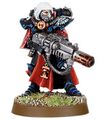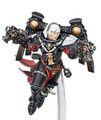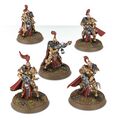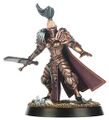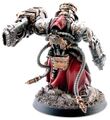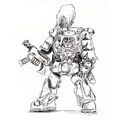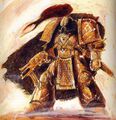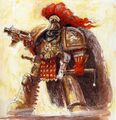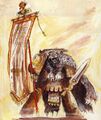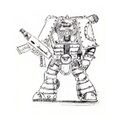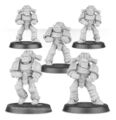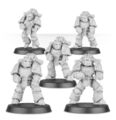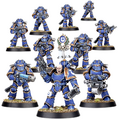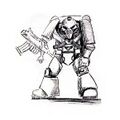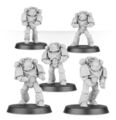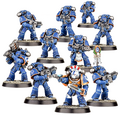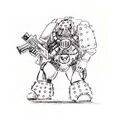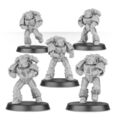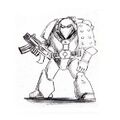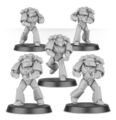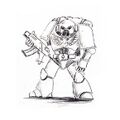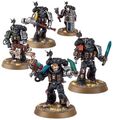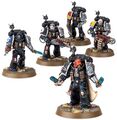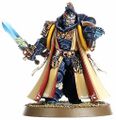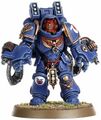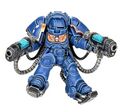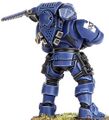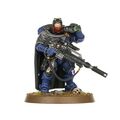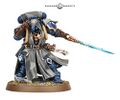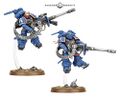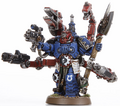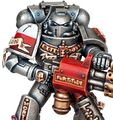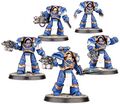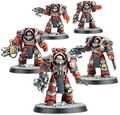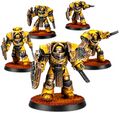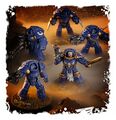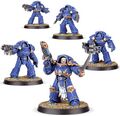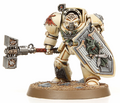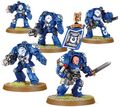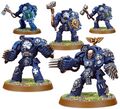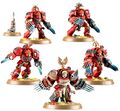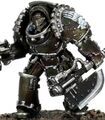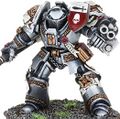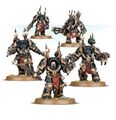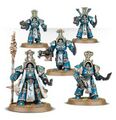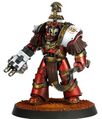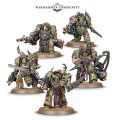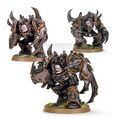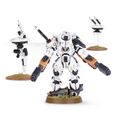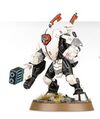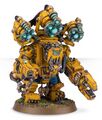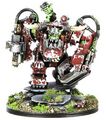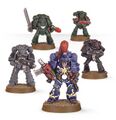Power Armour
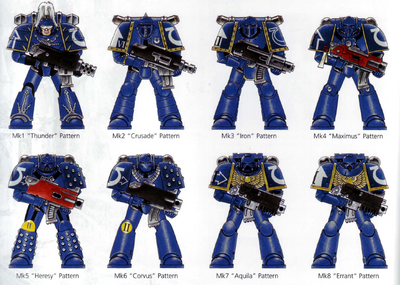
"Feels like you can take on the world in there, doesn't it?"
- – Danse, Fallout 4
Power Armour, also known as Power Armor to Americans, is a science fiction concept of mechanized armor which increases the strength, speed, and reflexes of those who wear it. It is featured heavily in science fiction/fantasy settings such as Iron Man or Warhammer 40,000. The idea of Powered Armor was invented by E.E. Smith and ripped off or borrowed and refined by other writers.
Before you add anything...READ THIS
Like Approved anime, /tg/ sure like their power armour. However, power armour is so ubiquitous with Sci-Fi that listing all of them would turn this page into a nightmare to navigate. So before you add your own section, ask yourselves this:
- Is it actually power armour? I mean, there are certain pieces of wargear that may look like power armour but actually isn't, at least not by definition. This gets trickier to identify and classify if your armour originates from a science-fantasy universe.
- Is it relevant to /tg/? And we don't mean is that power armour from Sci-Fi, no shit it is, what we meant is that does that power armour come from a well developed tabletop presence?
- Is it licensed from a traditional game? This ties back to the first point, it must also come from an official licensed IP, not some third-party source.
- Does it have any historical relevance? Does this power armour you listed offer any historical significance on its influence on the sci-fi genre and other forms of media?
If you do not think it fits in the article itself, add it to the relevant section of the article discussion page.
Starship Troopers
Like so many military science-fiction concepts, the modern idea of powered armor dates back to the Mobile Infantry of Heinlein's Starship Troopers. The "Marauder" suit is bulky, with integrated thrusters and heavy weapons (including nuclear weapons and heavy explosives, carried as easily as a human soldier carries grenades). Their primary purpose is not to destroy indiscriminately (though they certainly can), but to "make war as personal as a punch on the nose" -- to drop in and destroy with precision, in order to break the enemy in exactly the right way. In other words, it's much like Crisis battlesuits with less weeaboo and more humanity fuck yeah inside.
Heinlein never discusses pauldrons, but the Space Marines certainly take after the Mobile Infantry's other aspects.The dudes from the book not the movie. That was a parody anyway.
- Marauder: The basic infantry suit. Can carry more weapons than vintage Doomguy. Basic equipment includes radar and multi-spectrum vision aids.
- Scout: Lean on weapons, heavy on jump fuel. Much more mobile than the standard model.
- Command: Scout suit with more comm gear and gyros for inertial dead reckoning navigation. In practical terms each command suit is an instant, automatic, battlefield mapping system that can share its nav data with other command suits. This is the sort of battlefield data fusion tech DARPA wishes they could buy and have it actually work as advertised.
So how many weapons we looking at here? Well, in the first chapter of the book, Rico is participating in a quick raid on an alien city. Their objective was to smash and run, inflicting as much material damage as possible without the indiscriminate civilian casualties of strategic bombing. For this missions he dropped into battle with: a rifle, a heavy flamer, a handheld flamer, an automatic grenade launcher (called a Y-rack) and multiple reloads, conventional thrown grenades, incendiary micro grenades (called firepills), and one psy-ops grenade (a talking timebomb). And topping it off since Rico was a non-com working on the flank, he was issued a rocket launcher with four low-yield nuclear rockets.
Warhammer 40,000
Because 40k has a huge hard on for Space Marines, and because no super soldier worth his genetic enhancements will go into battle without super armaments, 40k has developed nearly as large a hard on for power armor.
Human Power Armour
Virtually identical to Space Marine power armor (More can be read below), these suits of armor are scaled down to fit regular humans (notice that this is the reverse of what it would have been 10,000 years ago). Human power armour is relatively quite rare, since it occurred to somebody that making good protection being an affordable and wide-spread asset would severely impinge on the current state of grimdark, not to mention expensive.
Without the extra room and black carapace interface Marine armor provides, many suits of human power armor don't offer the same degree of protection, as much strength enhancement, or as many subsystems found in Marine armor. Still, the wearer will still be stronger, better protected, and better equipped than the guy in cardboard. There are a few variants, including a lighter suit and one for Chaos-fighting Inquisitors. Because these things are still super-rare, usually only people rolling in money, tech fetishists, and those able to declare not giving them power armor is heresy, will have any.
Ignatus Pattern Armour
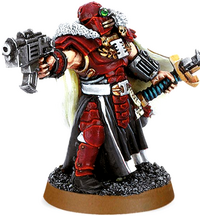
The most 'common' type of non-Astartes and non-Sororitas Power Armour.
The Ignatus pattern power armours are all fine examples of Mechanicus artisans. Each of them are individuality crafted only for representatives of the Inquisition. Of course not as durable as Adeptus Astartes power armours, the Ignatus-pattern is far better designed than those sold to nobles, rogue traders and other agents of the Imperium.
Like every other power armour variant, Ignatus armour is made of thick ceramite armour plates and incorporated electro-muscles so the user can even use the power armour in the first place. The optional helmet protects the wearer from toxic gasses, allows the wearer to breathe underwater, and even survive in a vacuum as long as the suit has power. The helmet has photo-visors so the user can see in the dark and an automatically closing visor renders blind-grenades useless against the wearer. They also have micro-beads and an integral auspex which can be controlled by speaking to the armour’s machine spirit, or the wearer could commune with his armour directly if they have a cerebral plug, MIU, or similar device. It is also possible to use a backpack for the suit which acts as an external power source. With this power-backpack, the wearer can use his armour for five continuous days in battle conditions.
Because the Inquisition often has to deal with Ruinous Powers and other heretical forces, Ignatus suits are commonly inlaid with hexagrammic wards.
-
Inquisitor -
Ordo Xenos -
Delphis Mk.II: Ironclad

A power armour that looks like something an Astartes would wear.
The Delphis Mk.II "Ironclad" Heavy Power Armour is a variant of standard non-Astartes power armour. It features increased personal protection at the cost of agility, with huge plates of Plasteel covering the flatter areas of the body. Exposed servo-mechanisms run along the legs and arms and elaborate bracing runs across the spine.
The helmet is small by comparison and the gauntlets are unwieldy to the point where basic actions beyond wielding a weapon is impossible. The power cell system in the rear has several thermal fins protruding to shed away excess heat. Ranks of power cells mounted on the rear provide 12 hours of continuous operation before recharging is needed, but require a day of recharging after each prolonged use. The suit is also a fully enclosed void suit and incorporates an inbuilt auspex, good craftsmanship photo-visors, an incorporated vox, and a pair of recoil gloves. If the suit becomes unpowered, vents open automatically in the helmet to ensure the wearer does not suffocate.
Each suit is a personal heirloom item, colourful paintwork and elaborate scrolls delineating the history of the various users cover the surface; some users have also added additional ornamental shields to indicate their personal heraldry. The more ostentatious suits may also include large retractable poles for flying more elaborate personal banners and their vessel’s blazons.
Because of all the layered protection, the Delphis Mk.II is the toughest and most 'powerful' of the non-Astartes power armours.
Sisters of Battle Armour
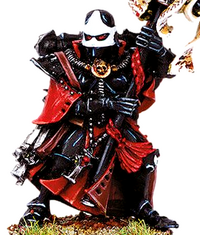
Less bulky than the Space Marine armour, as they're designed for normal sized humans. Despite Astartes & Sororitas armour both giving 3+ saves on the tabletops, in actuality the power armour of the Orders Militant of the Adepta Sororitas provides less ballistic protection than Space Marine armour does. (The identical in-game protection is mostly because saves in 40k are decided on numbers between 2-6, so there aren't as many gradients in-between.)
This armour also does not provide the same level of strength enhancement, but it gives enough to carry heavy bolters and ammunition into combat, and fire them without a sister shattering her arms. Sororitas armor has noticeably smaller pauldrons. The leading theory behind why they chose this design feature is that smaller pauldrons cut back the material cost it takes to create this variant, without having to sacrifice the pair of perky, globular breasts.
Helmets (Thereby known as Panty Helms, seriously, look at the damned thing) are not included as standard either, mostly because the majority of Sororitas models have spent hours doing their hair distinctive haircuts. But also because (according to Dark Heresy), the Sisters of Battle do not receive their helms until about halfway through their careers (how the sisters of battle are expected to fight in environments hostile to human life then is anyone's guess). This makes them inverse of the tradition held by the Astartes, where higher ranking officers are more likely to ditch their helmets instead.
The advantage of Sororitas power armour, though, when compared to other human-scales of power amour, is that it runs off of the same fusion reactor that Astartes armour does, and therefore can run indefinitely, rather than for a few hours at a time. Another advantage is that it is not as bulky so it does not turn the wearer into a big giant target either.
-
Dominion Battle Sister with half-mask.
-
Seraphim with power armour and jetpack.
-
What is seen cannot be unseen...
Vratine Armour
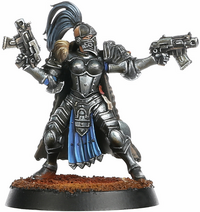
Exclusive to the Sisters of Silence, this is what the Null-ladies get to wear after finishing their training. The Vratine Armour is the armour of oath, containing designs akin to Space Marine Power Armour and possibly a local pattern from Luna (Selenite void-mail; Selene being a goddess of the Moon in Greek ROMAN GREEK mythology). Considering that the suit does not come environmentally-sealed like how Power Armour usually do (as you can see that the "helmet" is actually a full-faced mask) – though additional gear can be equipped to operate in a hostile environment – this armour that these Sisters wear is possibly the closest thing the Imperium has to the Mark I, which is also a Power Armour pattern that is not sealed.
On the other hand, the Sisters of Silence might have been a later addition to the Imperium over the course of the Great Crusade, and the design elements of the Astartes Power Armor is actually derived from a later pattern such as the standard Mark II, or maybe even up to Mark VI, assuming that the armour, like the Space Marines', has several renditions of itself. This is likely since the Vratine is designed with agility in mind, and the protection factor is also definitely not compromised for that.
As a side note, it doesn't have a noticeable reactor (much like Custodes armour) and is not called "power armour" anywhere in the FW books, but it is later identified as a form of power armour in the 8th Edition Sisters of Silence Codex.
-
Witchseekers in Vratine Armour without the helmet.
-
Vigilator with half-mask.
Dragon Scale Armour
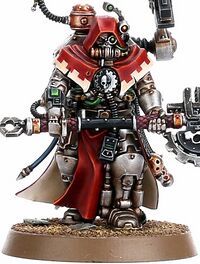
Consider this a catch-all term for any variety of proprietary protection in a given Forge World’s standing army, e.g., Crimson or Praetor armor. Dragon scale armor is basically Mechanicum power armour, commonly used by militant Enginseers of Imperial Guard and Myrmidon warrior priests of the Ordo Secutor. It does not have an external power source, as it derives power from your not-so-standard-issue Mechanicus potentia coil (and therefore cannot be used by anyone outside the tech-priesthood or high-ranking Skitarii). As such, it is more accurate to call it an augmentation than true 'armour'.
Not as thick as Astartes power armour, it sports many more inbuilt devices and sensors and gets further pimped by the Techpriest wearing it as he progresses through the ranks of the Adeptus Mechanicus to the point where it's hard to tell where the armour ends and its wearer begins. It is in some ways, similar to Iron Man's armor, but more steampunk. Some wonder if it is connected to the Void Dragon.
Each set of dragon scale is individually hand-forged from adamantine and ceramite plating depending on how much the Adept likes his style, and are woven with prayers of permanence and micro-etched with fractal incantations of defence. In a sense, Dragon Scale Armour provides a higher form of customizability and versatility due to the wearer's vast and extensive augmentations.
So if the wearer wants to be more agile, thinner pieces are used to offer lighter weight whilst implementing stronger servo-muscles for quick bursts of speed; if he/she wants to be a walking tank then the opposite happens as they are bulked up in thicker plates whilst the muscles are reinforced to provide durability and strength.
-
Myrmidon Secutor -
Myrmidon Destroyer
Squat Power Armour
Exo-Armour
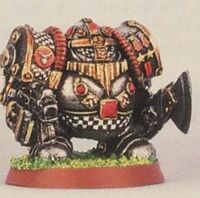
Our SPEHSS DORFS too, have their own power armour.
The humorously egg-shaped Exo-Armour is a type of heavy armour, comparable to Terminator Armour, used by the Squats. It is built by the Squat Engineers Guild. The extensive protection it provides is especially useful when fighting in confined spaces where movement is restricted and it is difficult to avoid concentrated enemy fire. Exo-armour is thus greatly valued by Squats, who often find themselves in combat in subterranean tunnels.
Exo-armour also serves as an all-enclosing hostile environment suit. The development of Exo-armour was spurred by the inhospitable nature common to the Squat homeworlds.
Exo-armour incorporates an integrated power axe and boltgun. Squat armourers are adept at forging magnificent exo armour, embellished with the visage of a Squat Ancestor Spirit. The armour is handed down from father to son and is probably the proudest symbols of status of the Squat military aristocracy.
The standard weapons fitted into suits of exo-armour are often upgraded to heavy or combi-weapons by wealthy Squat warriors. They are almost exclusively worn by the elite Hearthguards, although wealthy or prominent Squats such as Warlords and Living Ancestors are known to wear one too.
Space Marine Power Armour
The most iconic users of power armour in 40k are the Space Marines and the Chaos Space Marines. Made of ceramite layers upon plates of plasteel and adamantium/adamantite which will deflect all but the most powerful of weapons, Power Armour possess many life support systems designed to keep the Space Marine inside alive, even in the worst and most extreme of battlefield conditions. Has physical properties that has lead some material scientists (who clearly also do Warhammer) to speculate whether Space Marine armour is in fact an extraordinarily tough ceramic compound (ignoring all this easily trademarkable sci-fi bullshit about plasteel and adamantium/tite), which would make sense given that the Emperor actually invented very little new stuff when making the Marines' battle gear, instead just scaling up and making it bigger/louder/harder/better/faster/stronger etc.
The Black Carapace, one of the Gene-Seed organs, is specially designed to allow a space marine to interface his nervous system with his armour and is the last organ implanted in Codex Chapters. Amongst its features, power armour possess auto-senses to supplement the Marine's already considerable senses, auspex arrays to create minimaps and transmit data between squad members and commanders, painkiller delivery systems in the event of severe bodily damage, and waste recyclers to keep the Marine going for up to fifty days without fresh food or water. Or, for that matter, taking a shit. The connection between the two being one of the rather less dignified aspects of Astartesdom. The power source is a backpack mounted generator which needs initializing, but after that can take solar energy to keep itself going. According to GW, the backpacks themselves were inspired by the bedrolls (actually greatcoats in reality) carried by soldiers in the Napoleonic era. The "roll" on the backpack contains oxygen for use whenever the environment demands (like space combat) and the balls on the sides are either jet engines for manoeuvring in space or heat vents. Some early art showed they are more likely jet engines, and can lift a Space Marine for extra battlefield maneuverability, though presumably nowhere near as good as a Jump Pack. Running throughout the suit is a notoriously wilful machine spirit that maintains the armour and assists with the interfaces.
There are eight ten (technically nine because one has never been shown) types or Marks of Power Armour used by the Astartes. Regardless of their type, they all have massive Pauldrons, under which the Marine's ammunition is stored. Pictures can be found in the gallery at the bottom of the page.
Mark I: Thunder Armour

The first type of Power Armour was designed for the Thunder Warriors and worn by many of the techno-barbarians of Terra. They provided basic protection against weapons and enhancements to upper-body strength, but that is all - the suit was incapable of supporting its own weight and basic variant did not provide any significant protection to the legs. Which seems like a bizarre and terrible idea given that as any person who moves furniture often can tell you; you should do most of your lifting with your legs unless you want to give yourself a hernia, and as most soldiers can tell you, having to carry a lot of extra gear with the weight distributed onto your shoulders sucks and is exhausting, and being fatigued significantly hurts combat effectiveness. But perhaps this was intentional as the Emperor intended to replace the Thunder Warriors anyway. Since they were only used on Terra, there was no need to protect them against the void. Though the lack of life support systems and much lesser degree of protection make them essentially useless in the 41st millennium (this doesn't seem to stop people from pestering Forge World to make models for it though, even though they've said that they won't for exactly this reason), several Chapters retain sets of Thunder Armour for ceremonial purposes. If you were to field one now, it would probably count as carapace armour (4+ save) with a slight bonus to strength but a penalty to initiative.
In Deathwatch, you can actually get your hands on some. Be forewarned: it's noisy, doesn't offer as much protection, doesn't work with a Marine's Black Carapace, and actually might not be a whole suit of armour depending on its state of (dis)repair. Overall, it's kind of shitty, but it's a surviving artifact linked to the days of the living Emperor and early Imperium, and that impresses other Marines and those Ecclesiarchy schlubs. Take it for formal occasions.
Mark II: Crusade Armour
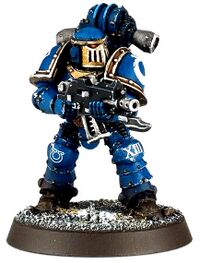
Designed by the Adeptus Mechanicus with the Great Crusade in mind, the Mark II armour was fully enclosed and contained all the life support and auxiliary systems now common among Astartes power armour, like a waste recycling unit and automated medical equipment. Much of these newer additions were made possible by a more efficient cooling system, which allowed a considerable reduction in the size of the power pack. For example, the chest coils, which were kept on the outside of the armour plating on Mark 1 armour for cooling purposes, have now been placed on the inside of the chest plates, so that they are better protected, thanks to more efficient cooling mechanisms. However, this design could not be copied over to the new powered leg armour, which resulted in exposed cabling on the backs of the lower legs.
The helmet also came with a bunch of enhanced sensory equipment, with the wearer is also able to see in the infra-red and ultra-violet spectrums, images can be zoomed in and magnified while noises can be enhanced. Overall protection and flexibility was much improved, especially since the legs were now enclosed in armoured hoops and came with their own servomotor, although with the caveat that the overlapping hooped armour plates being difficult to repair. Unlike the Mark I suit, the design is still sufficiently sound to remain in active, albeit extremely limited, use well into the 41st millennium.
Early depictions of this armour often featured a fixed helmet, similar to old-school diving suits. While Forge World completely retconned this away for the sake of compatibility with other Marine kits, there had been depictions of Mark II suits with movable helmets since the Rogue Trader days, so it's not like GW were ever consistent about it anyway.
-
-
Older version of the armour
-
-
The armour that carried out the Great Crusade
Mark III: Iron Armour
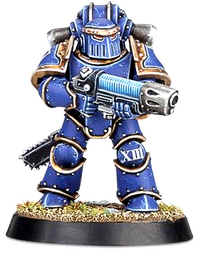
Mark III armour was first conceived for the Squat campaigns boarding actions of the Great Crusade. It was pretty much a modified Mark II designed to provide better frontal protection for close-quarters combat, essentially fulfilling the same role that Terminator armour would later fulfil. It should be noted that the Mark III was never intended to replace the previous Mark but to act as an optional suit specialised for the above-aforementioned situations. Because of this, no Legion was ever fully equipped with the Mark III. While successful in the conditions it was designed for, the armour was too clumsy and uncomfortable for conventional fighting.
By the time of the Horus Heresy, the Mark III was slowly being phased out and replaced by Terminator armour, but it's still fairly common among the Traitor Legions. In fact, several of the more traditional Legions were reluctant to phase out Mark III because it was the most brutally iconic mark of power armour in their day, so there was talk of keeping it for honour guards or spear tip operations.
Of course, since it was good enough that it did Terminator armour's job well enough to become "iconic" despite the Mark II being the primary issue at the time, then maybe they should've kept using it to augment Terminator forces when numbers were needed. Even into M41, the helmet or faceplate is still popular. It appears as a DLC armour in The Last Stand for the Space Marine Captain, where it increases the force of his melee strikes.
-
-
-
-
Heresy era Emperor's Children legionnaire -
Ultramarines
Mark IV: Maximus Armour
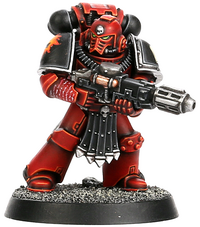
Now having access to more Standard Template Constructs, the Mechanicum was able to further refine power armour internal systems. In addition to having more advanced visual sensors, the helmet was now capable of easier movement. The suit was also made a whole lot lighter than before while only marginally reducing Mark II's protective capabilities. Bears mentioning it had much, much more superior manufacturability compared to MkII and was easier to repair due to its nature of having no interlocking armour plates and whatnot.
Although the chest power cables were once again relocated to the outside of the plating, they were given an armoured sheath to protect them from damage (since the gaps between armour are actually made of plasteel, that was likely used on the cables, as plasteel gives Terminator armour its legendary durability). Horus Lupercal manipulated the Mechanicum's supply lines to ensure that the Legions that were planning to side with him in the Heresy would be fully equipped with Maximus Armour in time for the Heresy; as a result of this, Mark IV was usually reserved for Chapter Masters and senior Captains of the Loyalist Legions. As the Legions were either fully or partially re-equipped with these suits by the time the Horus Heresy began, Mark IV is one of the most prevalent types of armour among the Chaos Space Marines.
It's a little strange that the Imperium didn't build more of them after the Horus Heresy, though, since it's far easier to produce and repair than the current Mark VII but not notably inferior. Seeing as they're always short on everything, you'd think these features would be the most important thing to consider for them (Apparently the Red Scorpions and Iron Hands are the only loyal chapters who still know how to produce them, and presumably won't share the STC for the same reason the Blood Angels won't tell people how to put Librarians into Dreadnoughts).
Some Chapters/Legions also made their own sub-patterns of Maximus power armour, such as the Ultramarines' Praetor pattern and the Thousand Sons' Achean pattern.
-
-
-
-
As a relic of the Angels Revenant chapter -
Tactical Squad
Mark V: Heresy Armour
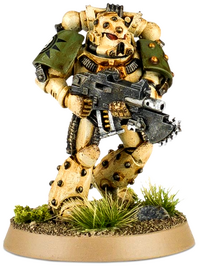
In between production of the Mark IV and what would be the Mark VI, both Loyalist and Traitor Legions found that they were running out of replacement parts for damaged systems. This would result in several Legions taking parts from older Marks and inadvertently making a brand new Mark of Power Armour. Although appearances varied widely as a result of its ad hoc nature, some form of standardization was achieved. One of the most notable was the introduction of molecular bonding studs on the left pauldron and both greaves (the famous "rivets"), which made them look totally Metal - these were actually originally designed to field-patch busted vehicle armour before they could be repaired properly. Probably one of the most common suits of armour in service among the Traitor Legions, since this was what most of them were wearing when they retreated to the Eye of Terror.
For a while, the Horus Heresy novels and black books outright retconned Mark V armour into a catch-all term for any improvised or prototype suits that existed outside of the main Mark series, yet weren't advanced enough to be considered artificer armour (likely so Forge World wouldn't get nagged to make variants of all their Mark III and IV squads in Mark V as well). However, they ended up backpedalling on this a bit in Retribution. The classic "studs and cables" version shown here is now apparently considered the "production" model of Mark V armour (presumably an Adeptus Mechanicus-sanctioned version that went into mass production), while the more variable, improvised suits it was based on are "non-production" models. Presumably, Forge World realised that the retcon didn't make much sense, since all known art and models of the armour up to that point were no less visually consistent than any of the other Marks (and arguably more consistent than a couple of them).
-
-
-
-
The Carcharodons favourite armour pattern
Mark VI: Corvus Armour
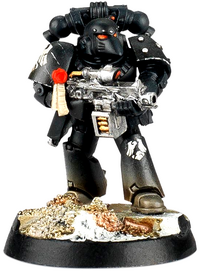
The much-beloved Beakie armour. Designed during the latter years of Great Crusade, this one was initially field-tested by Salamanders and Iron Warriors to become a proper Mk V. While the former's reaction is unknown, Perturabo despised the idea of reducing the protection of his cannon fodder sons. He arranged the next test to be conducted by the Raven Guard, and so Corax, whose tactics Perturabo despised, received a lot of Mk VIs and was sent on the galactic fringe to fight Eldar. To Iron Lord's surprise, the test was such a smashing success that the suit received the XIXth Primarch's name, and Beakie armour became a common sight in his legion even before it was actually accepted for service in wider Imperium. It anticipated some of the lately developed Mark VII features, producing a suit of armour that is in many ways equal to its descendants, if being a little bit specialized.
Although it offered the worst protection compared to all other proper marks, Mark VI armour was the first to feature a redundant power system and parts that are largely interchangeable with those of other marks, particularly with Mark VII. Somehow, it also manages to be lighter and fit together more smoothly than the current Mark VII Aquila, allowing for quieter movement, while the helmet includes further improved sensor systems in its, um, "beak". Due to the design's inherent stealthiness and legacy, it still remains the preferred armour among the sons of Corax, who tend to be saddled with older equipment anyhow. For reasons nobody can seem to explain, it was also sporadically used by the Alpha Legion around the time of the Horus Heresy even though it was never actually issued to them. Then again, it's the Alpha Legion so who knows.
-
-
-
-
A White Scars legion tactical marine -
Mark VII: Aquila/Imperator Armour
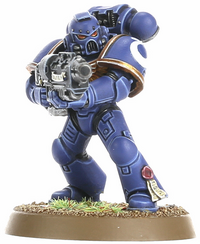
You know'em, you love'em. The most iconic Power Armor design in the franchise and also the Mark that has been in production the longest. Whilst other older Marks (With the exception of the Beakie Armour) was eventually phased out in the two centuries of the Great Crusade and Horus Heresy, the Mark VII chugged along for 10,000 years because the AdMech hit a Derp and couldn't be assed to make a new Mark until the return of Papa Smurf. Those lazy fucks. (Or more realistically, the Mechanicus didn't see enough significant reasons to replace the Mark 7, who was already pretty good as is. Extensive R&D, re-tooling entire Forgeworlds to meet new demand, and retrofitting existing suits with new parts aren't cheap, and that's on top of their 'Innovation is the Devil!' dogma.)
The most common Mark of Power Armour among loyalist Space Marines, Mark VII armour was still being designed when the Traitor Legions reached the Sol System and seized Mars. When this fact became all too foreseeable, Rogal Dorn ordered the design teams transferred to Terra to prevent the Traitors from seizing it. Mark VII featured completely covered chest and arm cabling, a distinct helmet that provided more protection, a high level of compatibility with previous Marks, and also bore the Imperial Aquila on the chest, which was first used there to provide quick identification of the Loyalist Marines during the chaos of the Siege of Terra.
Moreover, this Mark abandons the studded shoulder armour plate and replaces the helmet. As Mark 7 is a development of Mark 6, both have a great deal in common, and parts from one Mark are readily interchangeable with parts from the other, like the helmet. According to GeeDubs, the design of the helmet was meant to resemble a human skull, but you must be drunk from Mjord in order to see that resemblance. The Mark VII also contains its own back-up power supply and a solar array to recharge this, so the suit can operate even without its backpack though only a short time.
-
-
-
The most iconic pattern
Mark VIII: Errant Armour
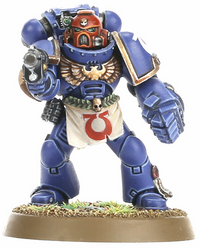
Jes Goodwin originally designed it with awesome Power Fist-style hands, a modified helmet, a streamlined power pack, and a more flexible leg-and-ankle joint. Games Workshop only bothered with using the altered breastplate, so the overall design looks like a regular Mark VII with a collar. That said, the more recent models for Space Marine Devastators have a flexible, ball-like ankle joint more in line with the original artwork. Deathwatch models have this ball-joint and the modified helmet, and Primaris models also have this ankle joint, presumably inspired by the Mk VIII like the breastplate collar is. Said collar is described as being brought into use due to an alarming pattern being noticed; namely, that bullets would deflect off the top of the breastplate and up into the bottom of the marine's helmet, killing him, or would pass in-between the bottom of the helmet and the top of the chest plate, into the marine's throat, killing him (similar to a problem found on the gun mantlet of Nazi Germany's Panzer V Panther D & A tanks in WW2, in which the rounded mantlet would send shells straight into the hull roof. Later Panther G models would have a "chin" to prevent this).
This was only really a problem with bolt shells due to plasteel armour protecting joints. But, when most of your enemies use bolts of some size or against Traitor Marines, this is really damn bad. Breaking the trend of reverse-compatibility between newer and older marks, this Mark can only accommodate the helmet designed for it, which kind of becomes a moot point when reserving it for officers, since everyone higher up than a Battle-Brother will never wear his helmet. The specialist design, or the Adeptus Mechanicus's head-up-own-arse tendencies around distributing new technology are thought to be the probable reasons why it has yet to be widely adopted among Space Marine chapters. Because of its rarity, the armour is generally restricted for use by senior officers only, and even then they'll usually only be able to wear the breastplate. The Munitorium series from GW, however, shows that it's fully compatible with Mk7, so Veterans will sometimes receive a part of Mk8 to replace analogue from their Mk7 for some heroic deed, meaning if some Veteran is equipped with full Errant pattern, he is a serious badass and likely expects promotion. The Minotaurs and Deathwatch chapters appear to be the exceptions here, as almost all of their Battle-Brothers have access to full suits, the former because they suck the High Lords' dicks and the latter because the Deathwatch is a special operations group made up of veterans of all chapters.
It should be noted that, while Artificer armour (at least in the art) looks like a pimped out Mk.VIII, regular Mk.VIII doesn't actually improve armour save. But Fantasy Flight gave it some love with an extra armour point all around, and the ability to deflect some headshots to the chest, greatly improving its protection and explained why so many officers using it tend to not wear a helmet (not to mention that the collar helps protect the neck from shrapnel or shots hitting it).
-
-
The Errant Armour comes as a standard...
-
in the Deathwatch, apparently...
-
The most complete depiction in official artwork to date
Mark IX Armour
Suffered the same fate as Windows 9. Who knows, really. This mark was skipped over when Mk10 was introduced, and no details were made available. It could either be an Mk5 treatment, with any Mk7 or 8 suits made with improvised parts or even contemporary Artificer Armour counted as the Mk9. Another possibility is that the Mk9 might be part of Guilliman's new job of actually getting stuff done and gets a new mark rolled out for the Classic Marines. Nothing's really known at this point, and there's still no word over three years after Primaris were announced. Why GW don't make a new set of models and saying that this Mark is used to bring Veteran Marines physical capabilities to Primaris level is a mystery for the ages. Then again, it could just be that Mk 10 sounds way cooler than Mk 9 (iPhone X and Windows 10, anyone?), although Geedubs did allude to its existence when Primaris armour was revealed to be numbered as 10.
If it helps, it has been suggested in forums and such, that Mark 9 power armour was that 'variant' which was used by pre-Primaris Librarians. Still, it is annoying that nothing official is there to be found. This could, of course, be nothing more than wishful thinking or plain old nonsense, as Librarians have been shown in various armour Marks, and some sources have shown their psychic hoods as a detachable add-ons rather than built-in.
Mark X: Armour System
A new form of Power Armor introduced in 8th Edition, worn primarily by the Primaris. Unlike all previous marks, the Mk. X was built with internal modularity in mind, and all their pieces can be swapped into another that make a single set or armour change its battlefield role. If the next mission is more stealth oriented, you don't need to ask for a new armour, just change the pieces into the ones of the Phobos; or if you're going to take heat, change it into a Gravis. It's basically kitbashing on an armour level. But this also lets you to create your own armour configurations.
There are several configurations that are currently in use:
Tacticus

The "default" form of the Mark X, the Tacticus configuration combines aspects of previous armour patterns, such as the Mk8 collar and the Mk4 helmet being the obvious bits, and all the latest technology of the Imperium in the 42nd Millennium. (Still doesn't affect armour save.)
So far it's only been shown on the Primaris Space Marines, it is unknown if the scruffy old obsolete Space Marines will get it. The vambraces are noted to have built-in cogitator systems, which can be used for a variety of purposes depending on the user's role, whereas the knee plates have its guard raised, protecting the joints. Other improvements include the Pauldrons which now incorporate a second armour layer, reactive armour and curvature which increases the armour's protection potential as well as a reinforced undersuit. Moreover, the armour also has socket ports for stim-injectors and diagnostic data-links, which makes the life of an Apothecary a whole load more easier.
On the other hand, the MkX backpack now has reinforced armour plates which offer better protection to the vulnerable fusion reactor. Like all MkX armour the Tacticus class is highly customizable, for example, the librarian has a Gravis style plated belly. Other changes can be seen across the range, such as the form-fitting greaves on the Chaplain, and the occasional addition of tassets to the hips (especially common on Hellblasters).
Due to the modular system of ceramite plating, maintenance cost is actually higher than older Marks of Power Armour. That and it's bigger too, which means more material cost on average (Although the high customization actually cheapens the overall cost of a Chapter's armoury due to the increased standardisation).
-
Primaris Apothecary -
Primaris Chaplain -
Primaris Librarian.
Gravis

The heavy configuration, the equivalent of Terminator Armour that grants +1 Toughness and +1 Wound as well as more mobility and flexibility. Yay. (Rumours that 8th Edition was being designed to make future video projects easier to code remain unfounded.)
Gravis armour is worn by the Captain included in the Warhammer 8th Edition Boxed Set. The example captain had both a master crafted power sword (that does two wounds nowadays) AND a brand new Boltstorm Gauntlet which combines the functionality of a power fist with a bolt pistol capable of firing at triple rate -- Marneus Calgar approves. Said armour design appears to take some leanings from... Iron Man (a noted early proponent for the founding of the Mechanicus, as such a most blessed servant of the Omnissiah), or perhaps the T'a *BLAM* HERESY!, or Terminators, with what appears to be augments on the legs, an enhanced ribcage, and an enclosed armoured hoodie for good measure.
Gravis Armour (like all Mk. X) is highly variable; for example the Inceptors have a Tacticus-style bodyplate and a retractable face-shield.
Gravis Armour is also worn by the Inceptor Squads, granting them the toughness boost as well. Their version also comes with built-in jump packs, replacing the normal backpack-worn type, and shutter style face visors. Another variant is worn by Aggressor Squads, which can come with Fragstorm Grenade Launchers.
Models in Gravis Armour are fucking big even compared to even the NuMarines, so... Primaris Centurion Armor.
Seems to be the most contentious of all the Mark X variants, by far. It really seems like you either love or hate this one.
-
Primaris Aggressor -
Primaris Inceptor
Phobos

Another Mark X configuration worn by Reivers, Vanguard Lieutenants (and other Vanguard HQs), Incursor, Infiltrators and Eliminators Primaris forces, the Phobos can be compared to the Mark VI Corvus Armour due to similar associations with recon troops.
Like the Mark VI, the armour is designed for silent infiltrations and drop assaults – and by "drop," it is sneakily by Grav-chutes, and not flashy like Jump Packs – and in the same way the older mark was pioneered by the Raven Guard, Phobos Armour was pioneered by the Primaris Reivers. Since Reivers from time to time enter the battlefield via air drop, the armour's power pack sometimes sports a pair of fins for the occasion. These fins are used to direct flight as the Reivers' Grav-chutes slow their descent. Whether or not those fins are the Grav-chutes themselves is arguable – probably unlikely because aside from Digital Weapons, Imperium tech does not shine really bright in the field of miniaturization; that is to say, their style choices usually go big or go home. Most of the Vanguard Marines seem to lack these fins, which supports the assumption that they're not the Grav-chutes themselves (Actually, only the Lieutenant in Phobos Armour has the Grav-Chutes ability out of the Vanguard, and he has the fins. Other Vanguard are just sneaky, and have Concealed Position instead, so they probably are Grav-Chutes). The Infiltrators' power packs instead sport a bunch of antennas, which make up an omni-scrambler system designed to conceal them from enemy auspex scans, while Incursors instead have a visor system mounted, allowing them to see through basically any obstructions to their sight.
The standard Phobos helmet seems to come in a couple of different shapes, which resemble either a Mk X Tacitus helmet or a Mk 7 helmet (both of which sport what seem to be some kind of rebreather system). The Reivers instead rock a Night Lords inspired (knock off) skull-helmet instead of a Raven Guard Beakie, which may or may not be awesome, and it amps up their voice to insane levels of sound.
-
Mask-only Style -
Grav-chute Fins -
Incursor
Omnis

Worn by Vanguard Suppressor Squads. It's basically just Tacticus configuration with Inceptor shock absorber boots, Reiver-style Grav-chutes, the Phobos' lack of gorget/collar, a miniaturised jump pack (which looks like a second pair of backpack exhausts with little tail stabilisers), and a new helmet visor design. May or may not offer a middle road between the Gravis and Tacticus configuration in terms of defence.
On the whole, the Omnis is lighter than the standard Gravis configuration due to the implementation of the above equipment. Of course, how it is made lighter, we do not know, as unless these armour pieces are intentionally made of a different material or structured differently, they look exactly the same as the rest of its contemporaries.
The models have been the subject of a fair bit of "debate" since their debut in the Shadowspear box, although that's likely got little to do with the armour they're wearing, and more to do with those ridiculously oversized accelerator autocannons that they're toting.
-
Vanguard Suppressors in Omnis.
Artificer Armour

Pimped out and individualized versions of regular suits, often enough to be considered one-off derivations in their own right. Artificer Armour can be formed from any older mark of Power Armour (perhaps barring Mk.I plate possibly excepting Thunder Warrior officers) by adding extra or upgraded protection. The upgraded and individualized suits mean that they require a lot of maintenance and needs techs to work around the clock to make sure they stay functional. In time suits become encrusted with unique decorations and individual upgrades and becomes known as Artificer Armour. Because of these heavy modifications, Artificer Armour is often highly superior to newer suits of standard-issue Power Armour, and afford much better protection.
So in simple terms, the more blinged-out the armour, the better it is stat-wise. With little to no standardisation, meaning that no two Artificer Armours are the same, design-wise. Standard issue for Techmarines, the Sanguinary Guard and optional for officers, pairing Artificer Armour with an Iron Halo can offer better protection than Terminator armour with none of the drawbacks, yet with only some of the benefits.
During the Great Crusade and Horus Heresy Space Marine Sergeants, the various Honour Guards (if they don't have the option of Terminator Armour) and even unaugmented officers of the Solar Auxilia could go into battle wearing Artificer Armor. Just another example in a long list that shows how the Imperium is a shadow of its former self. Yes, this means that every squad in 30k tabletop can have someone with a 2+ save in the pre-8th edition armor rules. Yes, it is hell.
-
Techmarine
Aegis Armour

The Power Armour of the Grey Knights, Aegis Armour is master-crafted on the forges of Titan and inscribed with prayers and wards to prevent Daemons from possessing it. Early fluff insinuated that several psykers were burned alive to be sacrificed as part of the machine-spirit of the armour, but this aspect has been downplayed massively in later revisions. (Considering the Golden Throne burns an ungodly number of psykers every day to keep Him alive, this isn't too farfetched; opinions nonetheless vary on whether this is true, and if so, whether it is Grimdark or Grimderp.)
Based on parts from Marks VI, VII, and VIII, within the breastplate of each set is a copy of the Liber Daemonica. It frequently bears a Stormbolter on its left forearm, keeping both hands of the wearer free to use. There is an Aegis/Grey Knight version of Terminator and Dreadnought armours, too. Just remember to keep any observations that Aegis Armour look in anyway similar to Tau Battlesuits to yourself.(But it isn’t made of paper.)
Could also be the aforementioned Mark 9, since the Inquisition scrubbing it from records if that were the case would explain why we know “nothing” about it.
-
Variant 1 -
Variant 2
Auramite Armour

The most common power armour within the Adeptus Custodes, it is straight up in the top 3 power armours of the Imperium, its other contenders being the Aquilon & Allarus Terminator armours. The material used for its construction is known as, you guessed right, auramite (which is ceramite, except even better): The first samples and tech to make it was brought back from the depths of Terra. Another interesting fact is that the servos and motors of the Custodes armour are nearly completely silent. Turning a Custodes into a sneaky marine. A very shiny sneaky marine, though the stupidity of this is somewhat lessened by the fact that auramite's colour can be alchemically altered to just about anything.
Custodes power armour also includes a built-in Grav-chute and internal air supply (But let's be honest, the Grav-chute is all but pointless since we never see it...well...anywhere). Each suit's helmet includes an internal vox, an altimeter, ambient neutralisers, and hololithic schematic overlay map.
The armour itself is even better than Artificer armour and includes a refractor field, essentially giving it the same properties in-game as Terminator armour. It can even get a teleportation transponder as well as an Arae-shrike: a nasty (so nasty the Mechanicum declared it blasphemous) piece of archeotech that fucks up nearby cogitators. The only ones allowed to make it, like all Custodes-grade weapons, are Emperor-chosen clans of Terra. Probably the only people the Mechanicus won't fuck with for fear of the golden bois getting...inconvenienced.
-
Sagittarum Guard -
Shield Captain -
Custodian Warden
Terminator Armour
Terminator armor, or Tactical Dreadnought armor, are set aside for space marine veterans who are exemplars of toughness, martial ability, and wonky proportions. This power armor provides the best personal protection available. Terminator suits have an outer shell of ceramite-bonded plates powered by electrically-motivated fibre bundles. Plates of heavy plasteel further armour the ceramite sections, especially on the front of the suit. This extra armouring provides a level of protection that is far superior to normal Marine armour; not even a Krak missile will penetrate the suit's breastplate (Which one wonders why Imperial tanks aren't coated with this stuff (cost/supply=/=demand). Moreover, external adamantium layered ribs help support this weight, while the inclusion of suspensors help the suit carry heavier support weapons, not to mention those indestructible pauldrons, a suit of Terminator armor is built to steamroll nearly everything and gives a fighting chance against everything else, which are the things that gives anybody else a fighting chance against Terminators. Standard loadout for Terminators are power fists and storm bolters, or Power weapons and twin linked bolters for the Chaos Terminators; but these are often and changed up with other heavy weapons systems, other killtastic melee weapons, and a squad is sometimes augmented with a shoulder-mounted missile racks. Since most suits are about at least as old as the chapter that owns them, and that the pauldron allegedly contains a tiny fragment of the Emperor's own power armor, these suits are holy relics as well as top shelf wargear.
Despite all the pain they lay down (and keep away), Terminator armor has a few serious drawbacks. First thing is that it is seriously hard to make. Seriously. Most chapters have only a handful that they can distribute amongst their veterans and officers, and any lost suits are damn near impossible to replace. Second thing is that they lack mobility. They counter this mostly since Terminator armor can be safely teleported from orbit into the thick of it, and judicious use of teleport homers can put them right where you need them, and a heavy transport such as a Land Raider can carry small squads. Beyond that, Terminators are otherwise going to be footslogging since they're too fucking huge to hitch a ride on anything smaller than a house. Better plan on not moving them too far once they hit the ground.
There are other patterns mentioned in the fluff but not yet seen on the tabletop, or available elsewhere in such small numbers they can be counted as unique variants.
The Minotaurs have widespread access to a rare type of Terminator armour, known as the Arkonak Pattern. However, every official illustration of a Minotaurs Terminator to date has them wearing either Indomitus or Tartaros armour, including their Chapter Master (the original Tartaros Terminator model).
The First Legion's Ironwing supposedly owned the greatest concentration of Terminator suits out of any of the First Founding Legions, and included a number (plural) of experimental patterns that were unknown anywhere else. Though Forge World neglected to describe or provide rules for any of them. So as far as we know they are just functionally identical suits of normal terminator armour that come in different shapes and colours.
Whereas Extermination claims the Alpha Legion used five patterns of Terminator armour during the Invasion of Paramar, suggesting that other patterns are yet to be revealed. Or, you know, the Alpha Legion being what it is could mean that their in house artificers are straight up inventing new technology or their infiltrators were stealing technology from other Legions.
Nevertheless, Terminator Armor has 3 major designs: the Cataphractii pattern, the Tartaros pattern, and the Indomitus pattern. As well as a few more lesser known but still prominent designs. More of which can be read below.
Cataphractii Pattern Terminator Armour
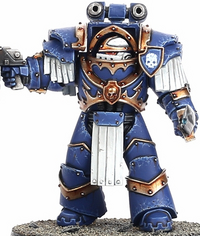
The oldest design bar a few prototypes and the first pattern to enter mass-production, developed during the Great Crusade and based on fusion-reactor maintenance suits. The Cataphractii pattern had Roman-esque, slab-like pauldrons (which apparently held shield generators), which enabled greater protection at the cost of preventing the wearer from moving with any sort of speed. It was the Mechanicus' intention to retrofit all 18 Legions down to the last Marine with Terminator armor at first, but it proved to be unfeasible as crafting those required far too many resources. In the end they were adopted for use in those situations where even Breacher squads struggled yet heavy ordnance was too difficult to deploy, typically boarding actions but not only.
After the Horus Heresy, Cataphractii pattern had eventually fallen out of general use. This may have been because the last of that armor was either lost in the fighting and the pattern became another lost technology in the following years. Or because production was ceased in favor of later patterns, and most suits were either cannibalized or became a relic that was the chapter's equivalent of fine china: makes a nice display piece, but practically useless due to enforced disuse. These relics wouldn't see field use again until the day GW released the Angels of Death supplement (no doubt because they'd sell more copies of Betrayal at Calth if both 30K and 40K Marine players could use it).
In crunch terms, this translates to a higher invulnerable save than the Indominus/Tartaros armor at the expense of losing the abilities make run moves or overwatch. In 8th edition, Cataphractii have reduced movement compared to the other versions as well as halved advanced distances, but get a couple alternate weapon options and retain their boosted invulnerable saves.
9E combined Cataphractii and Tartaros Terminators into a joint datasheet called Relic Terminators. While this bumps Cataphractii terminators up to a more standard 5" movement, it also drops their invuln save back down to a standard Terminator invuln save. They have a much more specialized loadout than regular terminators, so if you are looking for a more ranged variant of terminators, you'll probably want to look elsewhere.
-
Pict Captures -
Ultramarines -
Word Bearers -
Imperial Fists
Tartaros Pattern Terminator Armour
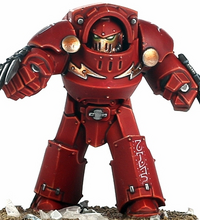
The Hulk Suit.
The most advanced pattern, using systems developed for the Mark IV "Maximus"-pattern powered armor. Tartaros Armor delivers the same level of protection as the Indomitus pattern but is much more mobile, with sensibly-sized pauldrons and an upright stance. Due to the advances in Pauldron Technology, Terminator Squads in Tartaros Armor can Sweeping Advance, unlike the others encased lesser models. It is however the rarest of models, since it was a very resource-unfriendly model to craft back at the time of the Heresy. In the 41st Millenium, any remaining Tartaros-pattern suit is a hallowed relic for whoever is lucky to still have one in functioning order.
In 8E's crunch, Tartaros Terminators move at the same speed as regular infantry in Power Armor (Which is pretty dang important if you're set up like an Assault Terminator) and also get a couple alternate weapon options, such as a grenade launcher and a Volkite Charger.
9E rolled Tartaros and Caraphractii terminators into a single datasheet referred to as Relic Terminators. Functionally, they're identical to the standard Terminator Squad with a minor difference in loadout options, namely the ability to take Plasma Blasters on their sergeants. Kind of a shitty fate for a unique set of models when GW is more than willing to make separate datasheets for every conceivable Primaris Marine they crap out.
-
Pict Capture -
Ultramarines -
Thousand Sons
Indomitus Pattern Terminator Armour
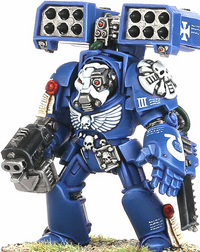
The Indomitus Pattern is the current pattern of Terminator armor (though the Forge World books make it clear that it was common at the time of the Heresy, perhaps more so than Tartaros and Cataphractii), sharing similarities with the Tartaros pattern in terms of functionality whilst being cheaper to manufacture.
As a later development that sacrificed a little protection for increased mobility and was (comparatively) easier to produce as previously mentioned, this was considered the Indomitus pattern go-to marketing ploy. This is the most commonly produced pattern, as Cataphractii armour was said to be in declining use due to its limitations and Tartaros armour was even more resource intensive to craft, placing Indomitus in a comfortable medium of "good enough". It has the familiar hunchbacked-bulldog/horse appearance, as seen in the majority of Games Workshop Terminator kits (although they now produce plastic kits for the other major patterns too).
Though inferior to the Cataphractii pattern in protection, and inferior to Tartaros pattern in mobility, the Indomitus pattern has quite advanced auto-sense systems that are unavailable in normal suits of power armour, and have not been entirely made evident from portrayals of the other types. These senses allow the user to track unseen targets and to know the precise location and condition of their squadmates at all times (while this is evident in the video games as a passive mechanic it can't really come up on the tabletop since the player sees everything anyway [except for "blips" in Space Hulk]). But these systems are noted in the RPG and various novels such as Master of Sanctity where the new user has to get used to a whole new suite of tactical information on top of actually learning how just to walk in the armour itself (hint: it's difficult).
A more interesting note is that this pattern also gave rise to the experimental Gorgon pattern (More of which can be read below), a design that was being tested during the Heresy by the Iron Hands Legion. There are also human-sized suits of Terminator armor, but the tiny amount of them that still exist are used exclusively by the Inquisition; even then, they aren't quite as potent as the versions used by Space Marines, due to lacking a Black Carapace.
-
The Deathwing is here. And it's very angry. -
Ultramarines -
Close Combat -
Blood Angels
Gorgon Pattern Terminator Armour
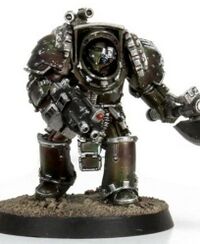
The aforementioned armour set. The Iron Hands also developed their own variant on the Indomitus armour, called the Gorgon Pattern. This armour was bonded to its wearer in a painful cybernetic connection, so he could never remove it (Kind of like a loyalist Fleshmetal Armour), but also meant he was even more resistant to injury, and it had a unique field effect that caused blinding bright flashes whenever it was struck.
Part of the reason why this armour pattern is so cybernetically-intensive is the fact that (Other than stroking the Iron Hands' technophiliac tendencies) the heat and electrochemical toxins bleeding from the suit limited the armour's agility, and its effects required a high level of cybernetic modifications for its wearer to endure.
This pattern is nowhere to be found after the Heresy, likely because Ferrus Manus didn't live long enough to work out the kinks in the design. Although, considering how similar it looks compared to the present Indomitus, it is a possibility that the Iron Hands had a hand in the creation of that pattern, whether as the designers themselves, or some Tech-priests (or Techmarines) managed to acquire the design and tinkered with it to make cheap Terminator Armour that could actually be taken off if needed.
-
Gorgon Pattern alternate view.
Saturnine Pattern Terminator Armour

Ah...the much famous egg-shaped Terminator armour which seemed to have been 'gifted' from the Squats Exo-Armour.
This was one of the most incredibly elusive pattern of Terminator armour, called Saturnine. It's got the biggest pauldrons one can get before moving into walkers category and was famous for it's extreme bulk, durability, cumbersomeness and difficulty of piloting - basically everything good and bad about Cataphractii turned to eleven. It never went out of field testing phase, since new smaller Castraferum Dreadnoughts could do everything Saturnine was designed for (boarding actions and indoor/tunnel fighting) better and without it's numerous drawbacks except for needing a half-dead Astartes. Some legions still had their batches of test suits when Horus Heresy hit and used them to gain whatever edge over their opponents they could, but they were never seen after the Heresy.
Nevertheless, the Saturnine pattern has occasionally been given a passing mention in Forge World's Horus Heresy rulebooks from time to time, where it was mentioned as being similar to the Indomitus and Tartaros patterns in function (if not design). However, some people have speculated that it is a revamp of an old Rogue Trader-era version of Terminator armor, as such a suit was recently shown in interior illustrations for the novella Meduson. From the pictures, this pattern looks like it is intended as a heavy fire platform, like a less Xzibit-friendly version of 40K-era Centurion Devastators. Which is awesome. However, this specialisation, and the fact that the armour was described as a custom job devised by Vulkan rather than a general-issue design, goes against it being the Saturnine pattern.
-
Truly old school. -
Note the unique back-mounted weapon attachment. -
Aegis Pattern Terminator Armour
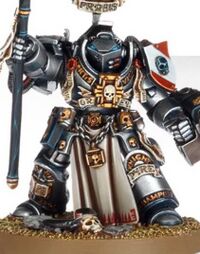
Just as how the Grey Knights have access to the normal Aegis Power Armour, the Silver Sues also gain access to the Aegis Pattern of Terminator armours, where the Aegis part essentially means the armor has its own psychic shield (inscriptions, holy water, all that blessing stuff) to deflect whatever Daemons or Psykers throw at it. Who does it anyway? Psyker Tech-priests? Nah, probably just their Techmarines.
In a sense, the Aegis Terminator Armour functions like a combination of the normal Aegis Power Armour and the Terminator Armour, creating a formidable defensive set piece against the most powerful of Chaos Daemons. These chaps are used when fighting the most clusterfuckery of Chaos invasions up to and including, a certain Daemon Primarch going on his happy murder spree on Armageddon.
They provide one of the best protection out of any armour piece save for the golden boys of course.
In 8th Edition, this pattern of Terminator Armour works like standard. However, with 2CP, you could use its Aegis abillity, which like in the Fluff, can be used in the psychic phase before a friendly GREY KNIGHTS unit attempts to deny the witch. They could then roll 3d6, picking the two highest when attempting to deny. Some Grey Knight veterans are still rather sore this is no longer part of the Special Rules which made them overpowered in 5th Edition.
-
Aegis Pattern alternate view.
Aquilon Pattern Terminator Armour
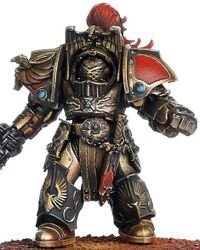
The Adeptus Custodes have Aquilon Terminators which is, no surprise, tied with the Allarus as one of the best armour sets in the Imperium. Period. The Custodes Terminators' armour was said to be Cataphractii pattern in the short story Hands of the Emperor, years before they got actual tabletop rules; this is technically still true (at least for 30K), depending on how you look at it, as Forge World made a point of describing the Aquilon pattern as a spin-off of Cataphractii armour when it debuted in Inferno, but with far greater power capacity and customized neuro-fibre uplinks, it is said, redesigned by the mind of the Emperor himself.
Aquilon Pattern Terminator Armour was said to have adjusted for the enhanced physique of the Custodes, who were capable of bearing more weight and strain than even Space Marines. This allowed it to be fitted with additional power systems and capacitors, increasing its durability and manoeuvrability. Aquilon Pattern Terminators were given more advanced weaponry than their Astartes counterparts, wielding weapons such as Lastrum Storm Bolters, Solerite Power Gauntlets and Power Talons, Infernus Firepikes, and twin-linked Adrathic Destructor. Like their lesser Auramite cousins, the Aquilon was clad in Auramite rather than Ceramite.
Within the ranks of the Custodes, Aquilon Pattern Terminator Armour was deployed by the Tharanatoi Caste. It is still issued as heavy assault armor ten thousand years after the Horus Heresy.
As expected, it has rules different from (read: better than) the Space Marine version. Much like Tartaros it can fire Overwatch and make Sweeping Advances. As seen from the list of gear above, Aquilons have better stuff than what Astartes of both flavours get.
Allarus Pattern Terminator Armour
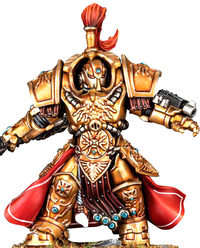
You think the Golden Custards just stopped at the Aquilon? Yeah no, they also have a second pattern called Allarus Terminator Armour for their 40K-era squads, which according to their community lore section on Terminator Armour was made the product of 10k years worth of research and development, and it shows. Lorewise Allarus Terminator Armour has greater durability than normal terminator armour, but none of the downsides, offering total freedom of movement.
Driven by magnatomic generator-shrines, articulated with leonus-class actuators, and fashioned from layered auramite and adamantium, Allarus armour is a marvel of craftsmanship. It provides its wearer with an exceptional range of movement and near-unencumbered speed, augmented strength and resilience. According to GW, it has the survivability to stride unharmed from the blast of a Macrocannon shell. Which we call Bullshit on that claim, since even the small ones from an Aquila Strongpoint is launching Schwerer Gustav-sized shells, no way in hell that the armour set, let alone the Custodes himself is capable of surviving a direct impact from that, so we could put it as more of GW shitty flowery language and hyperbole. Or someone slapped in one hell of a shield generator that constitutes the "cost more than worlds" section.
Going back on topic, the armour is also coupled with the protective blessings of the Emperor, Allarus Terminator plate is arguably the most effective man-portable combat armour in the entire Imperium. These expertly crafted suits are each individually worth entire worlds.
Crunchwise, in 9th Edition, these armour sets gifts the Allarus Terminators with four wounds each and equipped with Balistus Grenade Launchers in addition to their guardian spear/castellan axe...and can deep strike without needing the Stratagem to do so. Ouch. They're designated character killers, with Slayers of Tyrants allowing them to move up to 3" towards the nearest character when piling in and consolidating even if the character isn't the nearest enemy model. On the other hand, a Shield-Captain with the Allarus hass the same stat line but with an extra Wound, nevertheless, you also get the signature Balistus Grenade Launcher and From Golden Light special rule from the Allarus Terminators (for only 10 points more than the vanilla version at 109 points). You lose the Sentinel blade/Storm shield option, but the Eagle's Eye can fill in for it without making you give up any offensive capability. (Here's the humongous golden terminator daddy you've always wanted.)
Centurion Armour

The (in)famous 'Power Armor inside of a Power Armor' set piece.
Since somebody at GW forgot that the Xzibit meme wasn't funny anymore, Space Marines now have centurion armour that they equip like a miniature walker vehicle, more like a mini-mech, a cute little dreadnought preparing space marines for their life after living. Centurion armour is "worn" over regular power armor, giving better protection (like terminator armor without the invul save but with an additional wound, along with +1 to both S and T) and comes in two flavors: assault and devastator. Assault centurions are heavy assault units equipped with drills and meltas or flamers, meant to get in close to enemy strongpoints and fortifications and wreck shit. Devastator units are heavy fire support units with hurricane bolters and twin-linked heavy weapons, which, in practice, provide less fire power than regular Devastator Squads, but higher resilience and mobility, as the suits have Slow and Purposeful.
Fluffwise, the machine spirits on this thing is advanced, almost on par with the Land Raider's. There has been once instance where a group of Salamander Centurions were deployed to clear out a Dark Eldar incursion. The Dark Eldar released a toxin that liquefied people into soup and the marines wearing the armor eventually perished after their suits took damage and the toxin leaked through the cracks. A bit miffed after the loss of their pilots, the Centurion suits' machine spirits continued to fight on, even after their pilots were just fleshy goop at this point. They were eventually disabled, but not before killing scores more Dark Eldar during their rampage.
Paragon Warsuit

For more information, see here: Paragon Warsuit
This derpy contraption is the Sisters of Battle's new heavy armoured walking suit that straddles the line between power armour and a walker.
The Paragon Warsuit follows a similar mechanic as the Dreadknight, in that it actually has working mechanical legs and limb joints that the user physically controls with their own movements.
It differs from the Centurion however, in that the Paragon Warsuit is more than just a mainframe overlay. It actually has working mechanical legs and limb joints and the user controls it in the same way as the Dreadknight, just on a much smaller scale. So in a sense, it is basically the Sisters' equivalent of the larger Tau Battlesuits like the XV-8 Crisis Battlesuit hilariously enough.
Unfortunately, some Sisters seem to suffer from 'open head syndrome' where they ditch their helmet to look cool, which renders the entire point of the Warsuit meaningless.
Chaos Power Armour
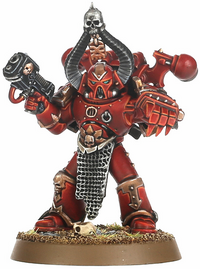
While many Traitor Marines are equipped with Marks IV or earlier (at least in the lore; if you go buy the models, almost all of them seem to have Mark VII armour with Mark VI legs), Chaos power armor is often a mix-and-match setup. About the only unified feature of Chaos power armour is a distinct power pack with stabilizers on long curved fins, that still runs on solar converter core instead of fusion reactor of modern loyalist power packs. Because Chaos Marines often have to go long periods with no access to proper industrial facilities, proper maintenance and replacement parts became an issue. Because of that, many subsystems in each suit of armor don't work and replacement parts come in the form of whatever they can dig up from plunder and take off of corpses after raiding and looting. Furthermore, Chaos Marines like to customize their armor with devotional iconography and personal trophies, making sure that virtually every suit of armor is personalized and none are exactly alike. Where things get even weirder is when the armor gets too steeped in Chaos and begins to twist, mutate, and turn partially organic, or had a daemon replace its machine spirit. It's quite likely that the parts of armor that don't work get replaced with warp magic, daemonic influence, or Dark Mechanicus tech-heresy.
Recent editions and artwork show senior Chaos marines with a sinister and more organic-looking power armour of Mark III through V, a look they pick up after a while either deliberately or due to the Warp's influence changing their outside look to match their corrupted souls. In the Rogue Trader Era, Chaos Power armor was organic, so this is actually a pleasant return to the old days. The Chosen models from the Dark Vengeance box set are commonly referred to as the harbringers of this new style, while the new Raptors/Warp Talons set incorporate this design, alongside the regular Raptors, whose design seems like being "metal-guilded armour, that's begun to blend together and form spikes and weird shapes", hinting of what's to come for the aging Chaos Space Marine range.
As of 2016, the non-Terminator-armoured Thousand Sons are now fully equipped with modified, ornate suits of Mark IV armour, in the style of the original Jes Goodwin Thousand Son model and concept art that established their aesthetic back in the old days. Since most of them aren't really capable of changing out of their armour anymore, this makes their current models their most lore-friendly--and least neckbeard-enraging--incarnation yet.
And then, in 2017, GW started releasing new Death Guard Space Marines. The ugly bastards pretty much relive the original style from the old Forge World Death Guard upgrade pack (itself a throwback to Jes Goodwin's Rogue Trader-era Death Guard concept), decked out in rotted, space-AIDS-riddled suits of Mark 3 armour, with most sporting the classic reinforced belly plate to hold in their bloated guts and intestines.
2019 finally saw a major update to the main Chaos Space Marine line, including two new kits for the basic Chaos Marine squad (a fully monopose, set-loadout one in the Shadowspear box, and a semi-monopose standalone version with more head and weapon options a few weeks after). The new sculpts are like a less ornate version of the Dark Vengeance Chosen, mixed with the old-Mark-heavy look of the 2nd edition CSM metals, and with better proportions than both. The new Chaos Havoc kit extends this style further by adding recoil-dampening talon mutations on the boots, as well as Mk III-inspired reinforced frontal plating (although the actual suits seem to be based on Mks V and later).
Warp-Forged Armour

Warp-Forged Armour is a type of armour worn by the warriors of Chaos. It is, as its name implies, forged from the Hell Forges of the Forces of Chaos. As such, these armour are partially daemonic and, given the lack of supplies from the Traitor side, it sort of counts as a form of homegrown power armour. Warp-Forged Armour is often made by either the Dark Mechanicus or the Iron Warriors, as these chaps are the only ones with the know-how in how to create and maintain these things. These armour pieces are mutated and possessed by a Neverborn and often worked in-tandem with their wearer.
One major advantage of these armour pieces is the fact that being partially daemonic, Warp-Forged Armour could heal over time, which eases the maintenance cost by a whole lot, and given that CSMs are in constant need for a diaper change, this means A LOT.
This daemonic armour is laden with unholy runes, allowing Champions of Chaos or Daemons wearing it to be all but immune to the blows of enemy mortals. In part of its nature, Warp-Forged Armour can be considered as the Chaos equivalent of the Grey Knights Aegis Armour. Chaos Champions and Chaos Lords who adorn these armour pieces could gain the added benefit of their armour regenerating due to it being partially daemonic.
They offer the middle ground between normal Chaos Powered Armour and Fleshmetal Armour.
Also, it’s partially daemonic. In case no one told you.
-
Chaos Chosens in Warp-Forged Armour
Chaos Terminator Armour
Just like their loyalist counterparts, Chaos too has its own pattern of Terminator Armours. Most of which are of the older Cataphractii and Tartaros Patterns since Chaos aren't known for its high maintenance standards, so by the 41st Millennium, some factions have kitbashed entirely new patterns for their Terminators.
Chaos Terminators as such, come in a variety of colours and flavours just like their loyalist counterparts. This is seen in the following:
Chaos Cataphractii Pattern Terminator Armour

During the Horus Heresy the Traitor Legions fielded units clad in Cataphractii armour just like their loyal brothers. They offer the most protection and are thus the toughest of the Terminator suits and are able to take immense punishment before suffering mass systems failure. They were armed with Combi-Bolters, powerfists and Grenade Harnesses, but also had access to Chainfists, Lightning Claws, heavy flamers and power swords.
Like their Tartaros cousins, they aren't as twisted as the Indomitus due to their rarity and lack of exposure from the Warp. Whatever is left of these tainted Cataphractii are now irreplaceable relics since Chaos can't maintain for shit. So they are usually of much inferior quality as a whole. On the bright side, Chaos Space Marines could be blessed with the Four Chaos Gods for additional quirks.
Crunchwise, they behave similarly to their loyalist counterparts, with the addition of having Chaos-aligned special rules and CP. In a nutshell, they are tanky, tough and has access to the favours of the Chaos Gods which makes them more individualised than their loyalist counterparts.
-
Chaos Cataphractii Terminators.
Chaos Tartaros Pattern Terminator Armour
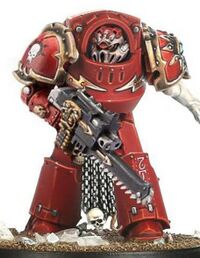
During the Horus Heresy the Traitor Legions fielded units clad in Tartaros pattern Terminator Armour, just like their loyal brothers. The most advanced and most mobile of Terminator suits, the Tartaros are surprisingly fast and can initiate a brief but surprising burst of speed to catch their enemies off guard. They are armed with Combi-Bolters and powerfists, but have also access to Lightning claws, Chainfists, Reaper Autocannons, Plasma Blasters, Heavy Flamers, Grenade Harnesses and Volkite Chargers.
Like their Cataphractii cousins, they aren't as twisted as the Indomitus due to their rarity and lack of exposure from the Warp. Whatever is left of these tainted Tartaros are now irreplaceable relics since Chaos can't maintain for shit. So they are usually of much inferior quality as a whole. On the bright side, Chaos Space Marines could be blessed with the Four Chaos Gods for additional quirks.
Crunchwise, they behave similarly to their loyalist counterparts, with the addition of having Chaos-aligned special rules and CP. In a nutshell, they are nimble, tough and has access to the favours of the Chaos Gods which makes them more individualised than their loyalist counterparts.
-
Chaos Tartaros Terminators.
Chaos Indomitus Pattern Terminator Armour
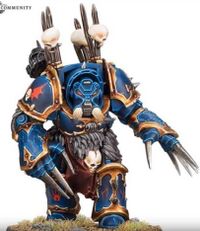
The most common and widespread Chaos Terminators and the most obvious. Similar to their loyalist counterparts, they are the most adaptable of the Terminators and are by far the most twisted looking due to the majority of Chaos Terminators wearing this particular piece of armor. Chaos Elephant Terminators are known for their notable tusks which has become an icon for Chaos Terminators. This is where the nicknames come from.
Now that the Horus Heresy fluff has been expanded, it is rather bizarre that these are the most common Chaos Terminators, as Indomitus Armor only became widespread after the Heresy, so most Chaos Legion Terminators should be wearing Cataphractii or Tartaros. Then again millennia of warfare and degradation has probably resulted in Cataphractii and Tartaros armour becoming quite rare due to the increasing difficulty in repairing it.
On the tabletop, these armour gives Chaos Terminators 2 wounds per model, making them as tanky as their loyalist counterparts with the addition on gaining access to the favours of the Chaos Gods which makes them more individualised.
-
Chaos Indomitus Terminators.
Scarab Occult Pattern Terminator Armour
See Main Page: Rubric Terminators
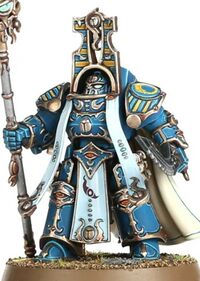
AKA Rubric Terminators or the Sekhmet. Scarab Occult Terminators were once the finest psykers in the Thousand Sons, bodyguards to Magnus the Red himself. Like their brothers, they were affected by the Rubric of Ahriman spell and turned into dust. Now they stride into battle at side of their sorcerous masters. Clad in ornate armor, they are armed with Khopesh blades and Inferno Combi-Bolters. The unit has also access to Heavy Warpflamers, Soulreaper Cannons and Hellfyre Missile Racks. The Sorcerer leading his unit also wields a Force staff.
Compared to most CSM Legions and Warbands, the Thousand Sons actually maintain their equipment quite well. While some may accuse them of excessive Nerdom, it may just be a manner of common sense which is a rare commodity in Chaos.
Strangely, the Sekhmet were the finest psykers of the Sons, so it is strange that they were rubric'd. However, the Sekhmet were rather emotionless and lacking in ambition, which doesn't fit well with Tzeentch's ideal sorcerers. Thus, rubric.
On the tabletop, due to being inanimate automatons, they get 2+/4++ saves as well as Fearless. What is surprising is that they lack the Slow and Purposeful rule, which actually makes them quite nimble for a bunch of walking trash bins. However, they still share in the Rubric Marines other traditional weaknesses. Such as general idiocy without a Sorceror and the lack of options to negate cover saves is a particular issue as the targets you'd want to use them against the most.
-
Scarab Occult Terminators. -
The Sekhmet Scarab Occult, pre-Rubric'ed.
Blightlord Pattern Terminator Armour
See Main Page: Blightlord Terminators

Blightlord Terminators serve as the disease-ridden elite of the Death Guard. They are bloated with disease and a myriad of parasitic organisms that spread a miasma of death and decay around them. They are so bloated with filth that their mobility has crawled to a snails pace; even regular Plague Marines can outwalk them. Despite this, they are orders of magnitude tougher then even regular Chaos Terminators and their status of being below a Deathshroud in rank is not to be underestimated.
Due to their level of mutation, they are forever fused with their mutated suits of Cataphractii Armour (A bit like Fleshmetal but more smelly), Blightlord Terminators combine diseased resilience with the protection and firepower of a standard Terminator. In battle, they serve as the elite shock troops of the Death Guard and are present in most warbands of the Legion and are essentially a neigh-unstoppable rape train.
Compared to the Thousand Sons' Scarab Occult Terminators, the Death Guard are the direct opposite when it comes to maintenance, for obvious reasons. Seriously, forget about even scavenging their equipment. Look at the damned thing.
Crunchwise, since they have Cataphractii armour, they are naturally a bit tougher than the standard Terminator. Since they are Nurgle's boys, they also get the standard +1 toughness and 5+ Disgustingly Resilient that regular Plague Marines get. All in all, a tough bastard to crack
-
Blightlord Terminators.
Fleshmetal Armour
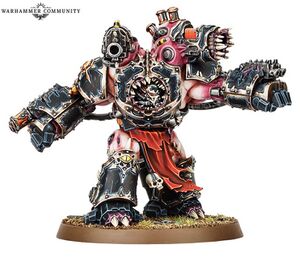
Essentially the Chaos Marine's take on Artificer armor, given only to champions favored by the Chaos Gods, although it would be much more accurate to call it as a type of Terminator Armour.
A blast from the past editions, Fleshmetal Armour is how it sounds. After spending gods knows how long in the Warp and centuries of combat under chaos, it eventually caused a chaos marine's power armor to fuse with their own flesh, forming an incredibly hard, organic carapace, tempered by ceramite and reinforced with warpfuckery.
Once a marine receives this gift, they're now more literal weapons than ever, as the armor cannot be removed anymore (since its now their second skin), condemning them to an eternity of unending war. Of course, since Chaos Marines live for that kind of thing, its more of an encouragement than anything. The only exception to this are Helbrutes, who are driven mad by the process.
Like Warp-Forged Armour, Fleshmetal Armour could heal over time due to being partially daemonic. This eases up on maintenance as wearers of this piece of equipment aren't desperate to scavenge for bits and pieces if one of their servo-motors stopped functioning. The one major downside is...well...you can't take it off now can ya?
Just about any Chaos special unit or veteran has fleshmetal armour, like Obliterators and Chaos Chosen.
-
Obliterators in Fleshmetal -
Mutilators in Fleshmetal
Tau Battlesuits
Main Article: Battlesuit
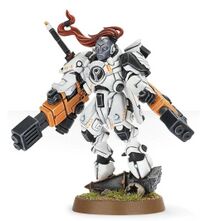
The Tau take on "power armor" is a bit more diverse compared to the Imperium because it encompasses both personal protective suits, like stealth suits, and giant weapons platforms, like Riptides. Essentially, the Tau classify everything from enhanced flight suits to nearly Knight-class units as "Battlesuits."
Pound for pound, Tau battlesuits generally have lower raw protective capabilities than their Imperial counterparts. However, they make up for this by having extremely advanced subsystems, high mobility, and devastating weaponry. The Tau Empire is also capable of mass-producing all its suits, in contrast to the Imperium which often resorts to assembling such advanced battlegear in an inefficient, individually handmade, boutique-style fashion.
It is important to note that Tau battlesuits can vary quite widely in form and function. Suits like the XV15, XV22, and XV25 are the closest in form to what the Imperium would consider true "worn" power armor. Meanwhile all medium-sized suits, which includes most designations from the XV8 through X104, are essentially small Mecha, with the pilot fully enclosed in a cocoon-like cockpit. Tau suits are certainly quite durable, but in contrast to Imperial designs sheer protection is not necessarily their most important function. Finally, the Tau place the largest units such as the KV128 and KX139 in a different category called Ballistic Suits, and do not consider them battlesuits as such.
-
XV15
-
XV22
-
XV25
Eldar Armour
Main Article: Mesh Armour, Aspect Armour, Exarch Armour, Phoenix Armour and Rune Armour

The Eldar use Mesh Armor technology to supplant their powered armor suits, said armor is made out of a combination of wraithbone and thermoplas, all woven together to make a futuristic mail armored suit. The suit is psychically attuned to the wearer's mind, so it is capable of tailoring its fit and use to the wearer's style.
While mesh armor doesn't seem or look all that tough, it's protective quality comes from it's ability to actively harden specific parts of the armor on neural impulse. Upon taking a hit, it will attempt to reduce damage by bulking up the affected part, then spreads the force of the hit's impact throughout the armor, which reduces the pain and injuries taken by the wearer since its not being concentrated to a single point of their body. We're not exactly sure how feasible this is, since the hardening only occurs upon getting hit (which means that the armor only has mere microseconds to do all this upon an object striking it), rather than in-anticipation like how reactive armor works IRL, but we're going to chalk it up to futuristic spehss elf magic.
There are currently a couple variants:
- Mesh Armor - Standard armor worn by guardian squads. Its also equipped with life-support functions and sensory equipment.
- Aspect Armor - Aspect armor are worn by Aspect Warriors. Each aspect shrine has their own take on Aspect Armor depending on their role, so Swooping Hawks and Howling Banshees have lighter armor, while Dark Reapers and Fire Dragons have heavier armor (although "heavy" is subjective as it still allows the wearer to be nimble like every other Eldar warrior). The main thing in common they have though, is that they're much more durable and flashier than standard mesh armor.
- Exarch Armor - Aspect armor worn by Exarchs. Because of the Exarch's seniority and experience; the armor is typically much more blinged out than the standard variant, offering the wearer more protection and other equipment options. Exarch armor is also adorned with the spirit stones of deceased Exarchs, bestowing the wearer with literally millennia of combat experience from past heroes.
- Phoenix Armor - The armor worn by the Phoenix Lords. Is so expertly made that it can withstand all but the most powerful and/or luckiest of hits, even after thousands of years. Phoenix Armor also stores the consciousness and memories of the original wearer, so in the event a Phoenix Lord falls in battle, he will be instantly revived when another living Eldar dons the armor again (although it has the questionable effect of completely overriding the future wearer's mind, with the Lord effectively making the unfortunate recipient a flesh puppet.).
- Rune Armor - Mesh armor worn by warlocks and farseers. Along with standard mesh armor tech, the suit is also inscribed with several runes that afford the wearer a greater deal of protection from damage, and also to better attune them to psychic energy. It also comes with an extra layer of wraithbone for more protection.
Dark Eldar Armour
Main Article: Kabalite Armour, Wychsuit , Incubus Warsuit and Ghostplate Armour
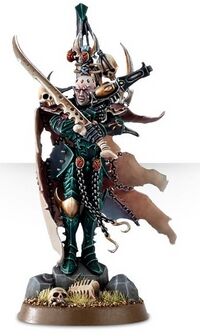
The Dark Eldar's armor is similar to their Craftworld cousins, although even lighter to accommodate the Dark Eldar's penchant for coke-fueled speed. Skimpier in the case of Wyches, who's career require them to show skin. They're also adorned with a plethora of spikes and blades, to the point that realistically: all those pointy sticks must affect unit cohesion and personal movement while in combat.
The few variants they have are:
- Kabalite Armour - The combat armor worn by just about every lowly kabalite that isn't going in naked. To further aid in movement: Kabalite armor is typically just a bodysuit, with armor plates attached where appropriate. They function similarly to mesh armor, in that the bodysuit hardens on neural impulse to deflect damage more effectively, and pressurized to allow the wearer to fight in hostile environments. Its also very, very spiky.
- Wychsuit - Not really "armor" per se, as a lack of one, but included for the sake of reference. Wych suits are flexible body gloves, cut away at certain places to show the Wych's good sides to the crowd while fighting in arenas or in the field. It offers very little protection due to the latter fact, as it's role is more for entertainment, than pure combat.
- Incubus Warsuit - The closest thing the Dark Eldar have to traditional power armor. It affords similar protection to that of Imperial power armor, whilst being so expertly manufactured that it doesn't inhibit the wearer's reflexes and agility in the slightest. The warsuit is completely exclusive to the Incubi, and not even Archons can pay/intimidate their way into getting a personal warsuit.
- Ghostplate Armour - Armor used by the poncier gits in Dark Eldar society, most notably Archons. The armor offers much better protection than bog-standard kabalite armor, whilst having a built-in forcefield generator. It also doesn't compromise on agility, as the resins used in it's construction are lighter and tougher.
Ork Armour
Main Article: Mega Armour
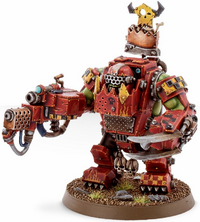
The only known variety of Ork power armour is Ork mega-armour, a direct Orkoid equivalent to Astartes Tactical Dreadnought armor. It basically looks like a chunk of metal or vehicle parts strapped together and called 'armour'. Or a miniature power lifter, whatever fits your definition.
Its weight (a ton or more) and complexity make it difficult to move and slow down its user, but it can withstand insane amounts of punishment, almost as much as Imperial Terminator Armour. Piston-enchased metal limbs of mega armour give the wearer phenomenal strength, and it incorporates fearsome weapons: a Power Klaw and Kombi-Weapon or twin-linked Shootaz. It often involves the use of built-in bionics and is very complex, which makes it very hard to manufacture, so it is a rare sight in Ork armies. Usually only Nobs (who like to call themselves "Meganobs" after acquiring Mega Armour) and Warbosses can afford such armour.
-
Big Mek
-
Ditto
-
Warboss
Battletech Battle Armor
Powered exoskeletons were a thing for civilian purposes in Battletech for centuries for civilian uses and some comparatively light power armor suits were used by the SLDF in the 28th century. However, it really came into it's own in 2842 when Clan Wolf took a Clan Goliath Scorpion diving suit design and militarized it. This development happened alongside Clan Hell's Horses coming up with a new beefed up strain of 2-2.5 meter tall Warriors, who they soon were plunking into these new suits. The result were known as Elementals, a nasty surprise for the Inner Sphere when they showed up in 3050.
Add the development of OmniMechs with universal docking ports, and the Clans developed new type of armored infantry who could recharge while riding BattleMechs into battle over vulnerable tanks. Battletech Power Armor tends towards the bigger side of things. An Elemental Suit would weigh one metric Tonne, can tank some fire from BattleMech-scale guns, comes with a Power Claw equivalent to shred armor, a jump-pack to get away, and packs some serious firepower with an arm-mounted lascannon alongside shoulder-mounted missile pods. The Inner Sphere responded by eventually developing the Inner Sphere Standard battle armor but were initially restricted to commando drops or defensive warfare due to a lack of mass production or OmniMechs.
Post Truce at Tukayyid, both Spheroid and Clanner factions began experimenting with a variety of designs ranging from light patterns capable of flight to quadrupedal one-man tanks able to take a BattleMech las-cannon blast to the face and still be able to fight. Like their BattleMech brethren, Battle Armor is generally categorized into weight classes with each having tradeoffs in terms of speed, stealth, armor, or firepower: Personal Armor - Light (500 kg), Light (750 kg), Medium (1,000 kg), Heavy (1,500 kg), and Assault (2,000 kg).
Gallery
-
The first five Marks through the ages.
-
Diagram of Aquila armour components.
-
Eternal Crusade concept art. Again, fitting real snugly.
-
It actually fits! Still a bit unsure about those hips though.
-
Japan's take on the Marauder Suit.
See Also
- For the 40kekkers in the room, an official animation of how Space Marines put their armour on.



